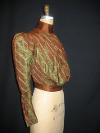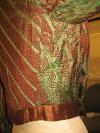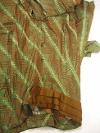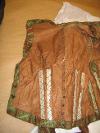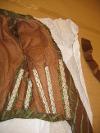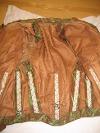This bodice, or “waist” as it would have been called, dates to the very late 1890s. It still has the small leg-o-mutton sleeves that were prevalent in this 1890s, but they are clearly not as large as some sleeves became during the height of this style. It also has the monobosom look and “pouter pigeon” shape that were popular during the early 1900s, as described by Blance Payne on pages 555-556 in the second edition of The History of Costume.
Figure 1: Bodice Front |
Figure 2: Bodice Back |
 |
 |
The 24” waist is consistent with 1890’s ideal of a small waist. The “wasp-waist” was a popular look during this period and the bloused front accentuated the smallness of the waist. Unlike previous periods where bodices were tightly fitted, it was common in this time to have a tightly fitted foundation upon which the looser outer bodice is mounted, according to Lucy Barton on page 506 in Historic Costume for the Stage.
The bodice itself is made of a green and brown chromespun silk taffeta. The crosswise, or weft threads, are green, while the lengthwise, or warp threads, are brown. This creates a "chameleon" effect where the bodice looks more green or brown depending on how the light strikes the fabric. It also has stripes of green, red, and white running lengthwise on the fabric. Between these stripes, there is a brown zigzag design woven into the fabric as well. The bodice is flat-lined with brown polished cotton, which was also used to bind the armscyes. The belt, bows, and detachable collar are made from three-inch wide, brown silk satin ribbon.
Bodice Construction
The back of the bodice has one back piece. There is no center back seam and it is evident due to the stripes on the fabric, that it has been cut on the bias. The shoulder seams are slightly dropped toward the back of the bodice, not riding on top of the shoulder. The bottom edge is shaped with a dip at center back.
The bodice has a side piece, beneath the armscye, that adds some shaping to the garment. This piece is almost entirely under the arm and would not have been very visible when the garment was worn. On the left side of the garment, the stripe that is in the center of piece has been matched to the line on the front of the garment. However, the panel on the right side is cut on a different grain and the lines of the fabric do not match either the front or the back. This panel may have been cut out of leftover fabric in an effort to be conservative with the fabric, since it is rather obvious that no attempt to maintain the fabric pattern was used.
The front of the garment is very different than the side and back panels. Where both of them are cut close to the body and very fitted, the front of the bodice is loose. There are no apparent seams when looking at the front section. It is gathered into the neck and hem at center front. This extra fabric created by these gathers gives the bodice the monobosom and “pouter pigeon” shape that was typical of the period.
Figure 3: Side Front |
Figure 4: Side Panels |
 |
 |
This bodice creates several impressions upon first glance that are, in fact, meant to fool the viewer. The first illusion is that there are no seams in the front panel. Close inspection reveals a couple of seams are hidden by sewing along the stripes in the fabric. These lines do not shape the garment, but allowed the rather large front pattern piece to be cut without visible seams.
The second trick of this bodice is the shape of the outside portion. The casual viewer would assume that the bodice would be both comfortable and loose because of its appearance. The loose and baggy front would seem to suggest a great deal of space inside the garment. However, this is not the case with these bodices. A look inside the bodice reveals that it is not as loose as it appears.
Attempting to look inside leads the viewer to yet another deception created by the appearance of this bodice. Again, the casual viewer will notice no closures on it. Without a center back or center front seam, and considering the fit of the collar, it would be impossible to put on or take off this bodice with simply a side closure. Closer inspection reveals that there are actually hooks at both the side seam and the shoulder seam on the left side of the bodice. These hooks, which close to thread loops, open to reveal a hidden front panel beneath. The panel extends to the center front of the wearer and has a set of eyes along the center front. These eyes match to a row of hooks set into the center front of the top front panel. In this way, there is actually a hidden center front closure.
Figure 5: title |
Figure 6: title |
 |
 |
From the inside of the bodice, one can see that it is actually quite close fitting to the body. The polished cotton flat lining, or foundation, is actually cut to fit the body snugly, allowing the fullness on the outside to be controlled and purely aesthetic. The front top panel is cut with a center front seam, and is shaped by two darts that extend up from the hem to top of the bust. The interiors of these darts have been cut away, the edges pinked, and bone cases have been cross-stitched onto the seams.
Figure 7: title |
Figure 8: title |
 |
 |
Based on the period of the garment, and assuming the bones and cases are original to the bodice, the bones would be actual whalebone, which was the most common boning used at that time. The bones and their cases are in great shape, but do not allow the viewer to see the actual bones for confirmation of their origin. The hooks at the center front appear to be a form of homemade hook tape that has had a strip of the lining fabric hand stitched to cover most of the hooks. The fashion fabric has been folded to the inside, folded again, and hand sewn down to the lining to finish off the edges. The bottom edge is faced with a shaped piece of the fashion fabric to both control the front gathers and keep the inside of the front smooth.
Figure 9: title |
 |
The hidden left front panel is shaped the same as the lining of the outside front piece. The two darts and the accompanying bones are placed to create yet another layer of structure and shaping to this “loose looking” bodice. A bone has also been cross-stitched at the center front just behind the row of hand-sewn eyes. The hem of this piece is cut just slightly shorter than the outside hem, keeping it hidden while being worn.
The side panel fashion fabric has been flat-lined to the lining and sewn into the seams. The side panel is the only body panel that is identical on the foundation and the fashion fabric. Again, the fabric was pinked and bones stitched over the seams. Catching the fashion fabric in the side seams in this way is what allows the back and sides of the fashion fabric to be so fitted while the front remains full and loose.
The back of the bodice is quite a bit different on the inside than it is on the outside. Here, the lining has a center back seam. There are also side-back princess seams which help to shape the back. These seams also help to explain why the back panel was cut on the bias. Despite design consideration, a bias-cut back panel would drape over the shaped back with fewer seams and thus allow the back of the garment to look smoother, without the bulk of additional seams.
This shaped back under layer also explains why the fashion fabric on the back of the garment is not pulled tight on the body. In this way, the cotton underlayer takes all of the strain and controls the fit, without putting unnecessary stress on the decorative, and more delicate, silk layer. This underlayer also helps to account for the amazing condition of this century-old garment.
Sleeves, Collar, and Belt
The sleeves have a leg-o-mutton shape, of a size that was popular in the 1890s, according to Blanche Payne on page 535 in the second edition of The History of Costume. These two-part sleeves are very full and gathered at the sleeve cap, but quickly taper to a fitted sleeve around the forearm through the wrist. The upper sleeve is cut on the bias, but the under sleeve is cut on the straight grain, giving more strength to the underarm portion of the armscye. The sleeve is completely flat-lined to the cotton of the inner bodice, and the fashion fabric is caught in the seams. The flat-lining is also gathered into the cap of the sleeve, which assists the sleeve in standing out and up, without the aid of a sleeve bolster.
Like the bodice, the hem of the sleeve is turned up and hand-stitched in place. Unlike the bodice, the seams of the sleeve have not been pinked; instead they have been hand-overcast to arrest fraying. The armscye has been bound with 1/4" bias strip made from the lining fabric. Hanging loops have also been sewn into the bottom of the armscye; there have been out of the lining fabric as well.
There are two collars to this bodice. The first a small band collar that is attached to the bodice, the second is a removable stiff collar. The small band collar is 11/16” tall and goes all the way around the neck edge of the bodice. This collar does not seem to have any special interfacing inside of it, but it does finish off the neck edge of the bodice. It closes with a hook and eye at the left shoulder seam.
Figure 10: Collar Band at Back |
Figure 11: Collar,Satin Surface |
Figure 12: Collar,Fashion Fabric Surface |
 |
 |
 |
The removable stiff collar is 2 1/8” tall; the tall collar being common on day dresses (Barton 505). This collar has the fashion fabric on the inside, but brown satin has been used to cover the outside. The satin, which began as a three-inch wide ribbon, has been pieced to allow it to completely cover the collar. This collar has a bow of the same ribbon to cover its hook and eye closure, and has a very stiff, buckram-like interfacing inside. Based on threads that are still sticking out of both the removable collar and the neck edge of the bodice, one can surmise that at some point the stiff collar was attached to the bodice. For this to have been true, it would have needed to close at the same place as the under collar, putting the bow off to the left side.
Figure 13: Belt Detail |
 |
The brown satin ribbon used to cover the collar, was also used to create a belt for the bodice. This belt has been pleated three times, with the pleats facing down, and shaped to match the bottom of the bodice. It has been tacked to the bodice to keep it in place. Unfortunately, the front of the belt has come loose and appears to have a raw edge, which makes it difficult to imagine what must have happened . An extra bow, made of the brown ribbon, which was with the bodice, suggests that perhaps the belt met at the sideseam and the bow hid the closure, but there is no evidence of this other than conjecture. This type of belt was common during the period and the bow as a finishing element was also common, Lucy Barton on page 506 in Historic Costume for the Stage.
The high collar, lack of frills or lace, and darker colors of this bodice indicate that it was probably a day garment, not meant for formal occasions. The belt on the bottom edge indicates that it was worn over a skirt. In the period it may have been referred to as a “basque”which meant that it was worn on the outside of the skirt waistband, rather than tucked in, Lucy Barton on page 506 in Historic Costume for the Stage. It is impossible to determine if there was once a matching skirt, although it would not have been unusual for the skirt to be of a different fabric. What is obvious is that this bodice was not worn extensively because it is in such amazing shape.
© M. Spencer Henderson, 2008


